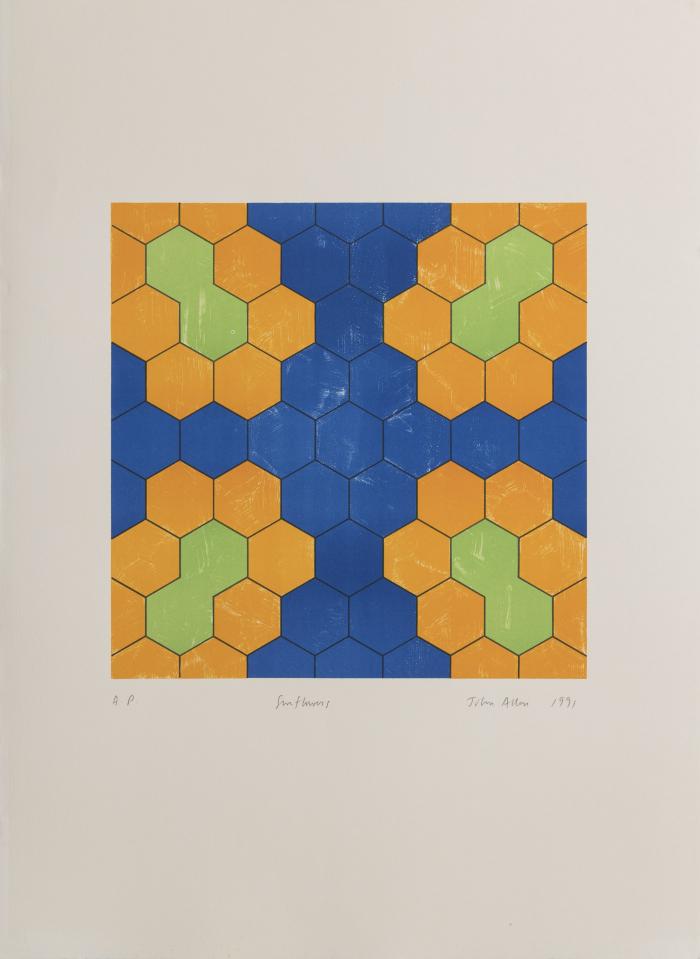
Sunflower
John Allen
- 1989
- Offset Lithograph
- Image/sheet: 30 x 22"
- 60 prints in this edition
About the Print
This abstract print by John Allen explores an understanding that the transposition of geometric shapes in dimensional space produces an image that is flat but presents the illusion of spatial perspective.
For a more complex view of how lines create shape, form, and a sense of perspective in works of art, view the video animation of the print Sunflower by John Allen, designed and created by students from Philadelphia high schools who participated in a Brandywine Workshop summer program. In the animation, the original printed This abstract print by John Allen explores an understanding that the transposition of geometric shapes in dimensional space produces an image that is flat but presents the illusion of spatial perspective.
For a more complex view of how lines create shape, form, and a sense of perspective in works of art, view the video animation of the print Sunflower by John Allen, designed and created by students from Philadelphia high schools who participated in a Brandywine Workshop summer program. In the animation, the original printed image begins with a line that first forms a 90-degree triangle and goes on to rotate into the forms of a pyramid, diamond, trapezoid, rectangle, and — ultimately — three-dimensional shapes that, while moving through space, form a pattern.image begins with a line that first forms a 90-degree triangle and goes on to rotate into the forms of a pyramid, diamond, trapezoid, rectangle, and — ultimately — three-dimensional shapes that, while moving through space, form a pattern.
—From Brandywine Workshop and Archives and records
About the Artist
John Allen is a New York-based artist born in Sagamihara, Japan. He earned his BA in mathematics and art from the University of California, Berkeley, and an MFA from Hunter College, New York City. He is an adjunct assistant professor in the Fine Arts Department of the School of Art and Design at the Fashion Institute of Technology, New York City. He has also taught at the State University of New York, Purchase, and Hunter College, City University of New York.
He has exhibited his work at institutions throughout the New York region including M55 Art, Long Island City; Paula Cooper Gallery, The Drawing Center, Coup De Grace Gallery, Artists Space, White Columns, Asian American Arts Center, Kenkeleba House Gallery, and Basement Workshop’s Catherine Gallery, New York City; Kingston Sculpture Biennial; Hallwalls, Buffalo; Chesterwood, Stockbridge, MA; Hudson River Museum, Yonkers; Hartwick College, Oneonta; and Longwood Arts Gallery and Bronx River Art Center, the Bronx. He received New York Foundation for the Arts’ Artist Fellowships in Painting in 2000 and 1984; Public Art Fund Award; Jerome Foundation Fellowship at Robert Blackburn’s Printmaking Workshop, New York City; and was an artist-in-residence at Brandywine Workshop and Archives, Philadelphia.
—From Brandywine Workshop and Archives records
Curriculum Connections
Suggested Topics for Algebra I and Geometry
Algebra I:
The resources provided can be used early on in an Algebra class to help students think in multiple dimen- sions. The artworks can be used to demonstrate illusions intended as a design element or to help students imagine space constructed or deconstructed from forms or shapes within a space. The ability to visualize concepts through art can make advanced math more accessible to students early on.
Geometry:
Some may want to use images in the Artura.org library to explore more complex uses of advanced math to create the illusions of space and solve spatial dynamic issues for three-dimensional works such as stand-alone sculpture and site-specific, public artworks. The laying of bricks or ceramic tiles is a skilled craft that can involve creativity and innovation in bricks or tiles are set and many available options in color, design, and texture are used. Sculptors such as Melvin Edwards, Richard Hunt, and John T. Scott have consistently used higher math concepts in the creation of large scale, space-defining public art.
Questions to Consider
- What are the different considerations between symmetry and asymmetry in relation to designing a structure or composing a work of art?
- What roles can rhythm, repetition, pattern, proportion, and scale play in an architect’s design and construction process? What roles can they plan in making a work of art?
- Other than the design of buildings, where else does one observe the use of the right angle in a creative way and for what purposes?
